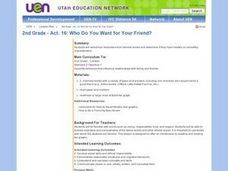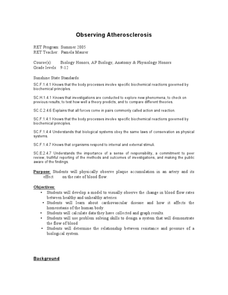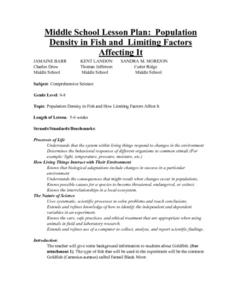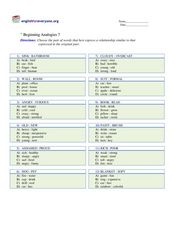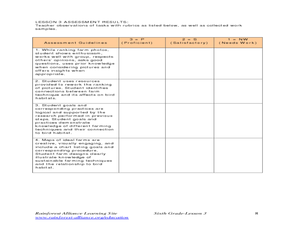Purdue University
Well-Being: Dimensions of Wellness
A unit on well-being begins with participants completing a self-assessment worksheet. After reflecting on the results, individuals set well-being goals for themselves that are SMART (Specific, Measurable, Attainable, Relevant, and...
Curated OER
Who Do You Want For Your Friend?
Second graders create a t-chart about the healthy and unhealthy characteristics in relationships. They discuss elements they should look for in a friend. They are read books to identify these elements.
Curated OER
Beginning Analogies 9
In this analogies worksheet, students read the word pairs and choose the answer that best expresses a relationship similar to the original pair.
Curated OER
Heart Disease Prevention
Fourth graders get into groups and brainstorm ways to obtain physical activity and different healthy foods to eat. They then develop and write and individual plan for healthy living and commit to enforcing their plan for a minimum of one...
Curated OER
Learning to Love
Students discuss the different kinds of love and the characteristics of a healthy relationship. They examine types of behaviors that could make a relationship unhealthy and name components of love. They evaluate their current...
Curated OER
The Human Body: Focusing on Respiratory and Circulatory Systems
Students study the components and functions of the respiratory and circulatory systems. They take blood pressure using a stethoscope and investigate ways to maintain a healthy respiratory system.
Curated OER
Observing Atherosclerosis
High schoolers develop a model to visually observe the change in blood flow rates between healthy and unhealthy arteries. They calculate data that they have collected and graph their results. They determine the relationships the flow...
Curated OER
Eat Right, Stay Fit
Students examine what a healthful diet is, and examine their own eating habits to see if they are getting the right foods to stay healthy. In this eating right lesson students keep track of what they eat for several days and evaluate it...
Curated OER
Habitats
Students participate in an online lesson to determine that different plants and animals are found in different habitats. They use food chains to show feeding relationships in a habitat, and see that nearly all food chains start with a...
Curated OER
Smokey's Message
Learners list and discuss positive and negative effects of wildland fire. They discuss relationships among ecosystems and fire. They participate in role-playing activities related to wildland fire management.
Curated OER
Let's Think About Day and Night
Students explore day and night and the relationships between the Earth, the sun and the moon. They discuss the ways in which the sun and moon help us. They watch a short video that helps illustrate these concepts.
Curated OER
Population Density In Fish
Students investigate how a population of fish multiplies in an ecosystem and the kinds of things that must be done to maintain a healthy population balance with other organisms that live there. They conduct an experiment to test the...
Curated OER
Beginning Analogies 7
In this analogies practice worksheet, learners respond to 12 multiple choice questions that require them to express the similar relationships between pairs of words.
Curated OER
Conditional Exercise 1: If/When
For this conditional if/when worksheet, students fill in blanks with the best conditional, if or when to show relationships between statements/events. A reference web site is given for additional activities.
Curated OER
Resistance to Parents
Students examine family life issues. In this interpersonal relationships lesson, students discuss typical resistance to parents from teen children. Students also discuss options for children dealing with difficult or abusive home life.
Random House
Recipe for an Ecosystem
Creating an ecosystem is as simple as baking a cake. Well, maybe not, but using a recipe analogy helps learners realize that ecosystems consist of different components that come together in unique ways. Offer this worksheet as an...
Curated OER
How can my breakfast help the birds?
Sixth graders design farms with a bird's habitat in mind. In this farm lesson plan, 6th graders research how sun grown coffee destroys a bird habitat, and then they make their own farm with a bird's habitat being preserved. They then...
US Institute of Peace
What Does Conflict Mean?
Is conflict always bad? Learners begin a unit on conflict resolution with an exercise that defines conflict, reviews common words associated with conflict, and encourages partners to brainstorm conflicts that may have positive results.
Curated OER
Guidelines for Sexual Health Information and Disease Prevention
Students describe effective sex education and its outcomes. They provide a tool for educators, policy-makers and others to evaluate existing or new programs, curricula or policies. Students comprehend that sex education refers both to...
Curated OER
Family Mealtime: Take a New Look
Students share their family mealtime experience. For this adult health lesson, students explain the benefits of eating together. They share ideas on how to make mealtime fun.
Curated OER
Friendships Tied in Knots
Fourth graders engage in a lesson which emphasizes characteristics of healthy friendships and how these characteristics can be utilized to solve the knots in the rope representing an unhappy friend relationship.
Curated OER
Web of Life
Students work together to create a web of life. In groups, they put on nametags and form a circle. They toss the ball to a random person in the group and they make a connection between the person throwing the ball and the person...
Curated OER
LABOR UNIONS IN THE 21ST CENTURY
Students define and discuss labor unions in the United States. They compare and contrast labor unions in the United States and labor unions in Europe and Japan.
Florida Department of Health
Safe and Happy: Safety for All at School and Online Unit
Bystander or upstander and advocate? Three lessons have high schoolers investigating data about bullying and school safety. Participants then learn how to take a stand against bullying and use what they have learned to create a PSA to...



